A Review of my Glow In The Dark
Deep Sea Fish Replica Toys: Safari vs. AAA
In 1997, the Safari brand released "Creatures of the Deep," a set of soft plastic deep sea fish from five to six inches long and with bright glow in the dark features. My mother bought me this entire set as a surprise Christmas present that year, and virtually every year of my life since then, wherever I happen to be living, the entire set is sitting around my sleeping area or hanging from the ceiling, still glowing every time the lights are turned off.
But until roughly the 2010's, I never knew that another company, AAA, actually produced a knockoff line amusingly called "The Bottom Feeders." Some of these would be direct imitations or repaints of Safari's figures, while others were entirely different species, and I'm not quite certain how or why; did they sculpt a few of their own, then steal the rest of the designs, or did they get their hands on some unproduced Safari molds? In any case, The Bottom Feeders would start cropping up again on the internet a few years after I found out they existed, and I snatched an incomplete set the moment I possibly could. I haven't really reviewed any animal toys since my old, broken Rubber Bug galleries, partially because there's already a whole community dedicated to doing so, but we'll see how much people enjoy me, specifically, going over these plastic fish...
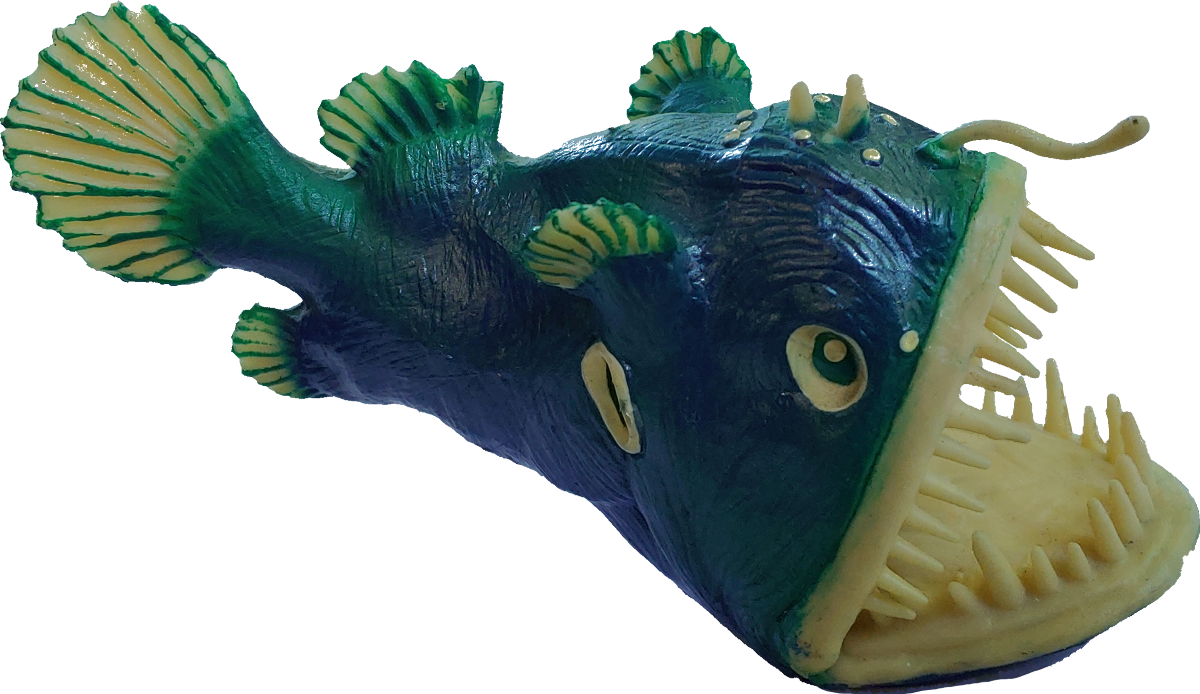
Safari co: Black Seadevil
Safari only labeled this an "Anglerfish," which is fair, because it's exactly what nearly everyone pictures in their head when they hear the term. There are five known species of seadevil in the deep ocean, as far as we've ever found, and this figure is most likely based on the hump-backed angler, Melanocetus johnsonii. Safari's is a beautiful, almost metallic blue-green, rather than the equally beautiful brownish black of the real animal. The paint shows up a much lighter, brighter green just where it meets the creamy, translucent fins, jaws, eyes, gill openings and illicium (the "lure"), all of which glow in the dark. It's the bulkiest of these figures, and its weight is nicely distributed such that it stands perfectly on its lower jaw!Contrary to popular misconception, not all deep sea anglers have "parasitic" males, and in fact, the iconic seadevils are among those exceptions! Their males are still just little guys who live only to mate, but they live only a short period and die after fertilizing a female's eggs, rather than fusing into her flesh like a proper gentleman.
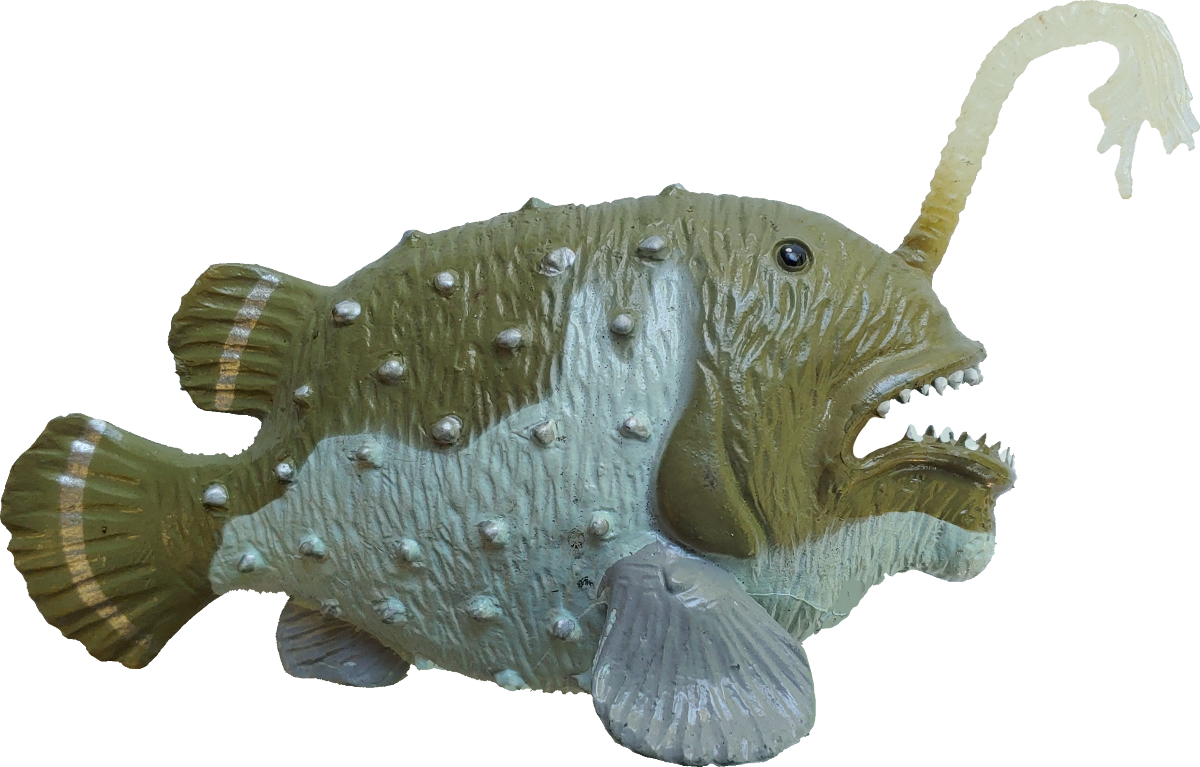
AAA: Footballfish
AAA's "Bottom Feeders" includes a very different type of angler, a member of the "football fish" family. It's a little off looking, especially having a somewhat droopier face and more of a "chin" than the real thing, but it somewhat resembles Himantolophus groenlandicus, the Atlantic footballfish, one of several species covered in short spines. AAA gave this one a brown body with splotchy white sides and pale stripes on its fins, even though the real thing is mostly black. The Bottom Feeders are cast entirely in a more translucent glow material than Safari's, which looks even cooler against bright lighting, but unfortunately, the chemistry of this plastic has caused every single Bottom Feeder figure to become slightly greasy and sticky over time; I've gotten mine from different sources, and all of them were sticky like this.That aside, the footballfish is painted everywhere except the illicium, so it's more accurately the only part the really brightly glows. It's a longer lure than those of the seadevils, and in life, it branches into a cluster of tentacle-like filaments, sculpted as one mop-like bundle on this figure.

Safari co: Viperfish
Safari's viperfish most closely resembles Chauliodus sloani, except that they made its skin a bright baby blue. I like the look of it, though it would accurately be more of a shiny silver all over, which they did do for another of this line! Like their seadevil, it's not just its lure that glows but also its teeth, fins and entire eyes. They did include small dots of light down the sides of the body however, which is accurate!Viperfish, like a lot of deep sea predators, swallow prey whole and have distendable stomachs, allowing them to collect plenty of food at once and digest it over a long period, like a snake!
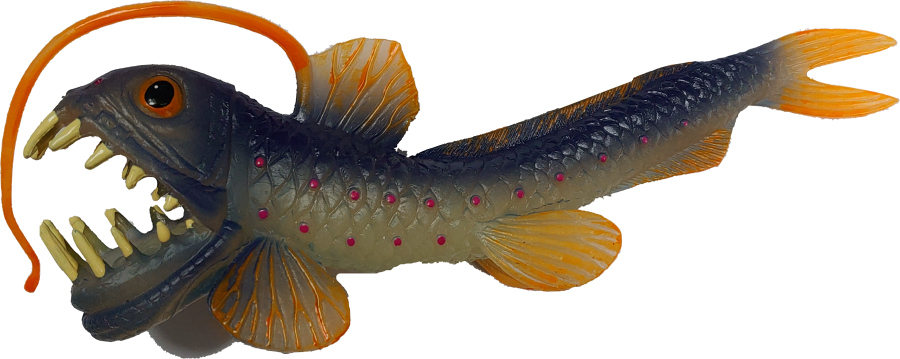
AAA: Viperfish
AAA copies the Safari viperfish very, very closely, but the lower jaw has more of a "chin" and it has a more elaborate color scheme, including an intensely orange illicium. The material also makes the illicium really soft and floppy, whereas Safari's is pretty stiff. I think I actually like AAA's viper a lot more!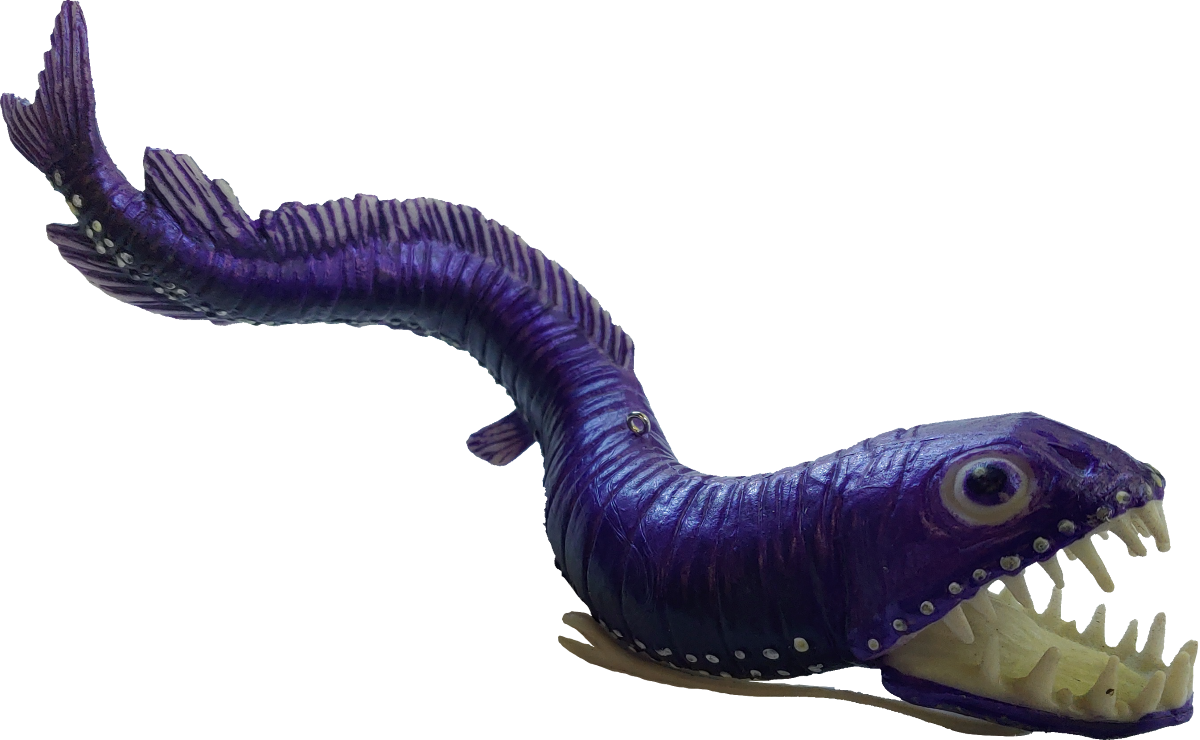
Safari co: Black Dragonfish
A black dragonfish is, of course, black, but Safari's is a deep, shiny purple. It's close enough really, and it just looks cool! Dragonfish are closely related to viperfish, and both share a bizarre larval stage with a tiny, toothless mouth and eyes on long, dangly stalks. Where the dragonfish differ most is in how they use their light; many deep sea predators can barely see their own bioluminescence, and they don't need to, since the food comes to them anyway. The dragonfish, however, don't just use light to lure prey; their large, sophisticated eyes can see into the infrared spectrum, and they emit infrared "spotlights" from behind their eyes, meaning they can illuminate their surroundings with a red glow invisible to most of their prey as well as larger predators. Secret deep sea night vision goggles.This one is probably based on the most famous species, Idiacanthus atlanticus, but tragically, the headlights aren't represented at all.

AAA: Dragonfish
AAA's dragonfish is a completely different design from Safari's, likely representing a much shorter-bodied species, but the head is also a little more "stylized" and not totally accurate, having slightly smaller eyeballs in a larger looking skull. It's a great looking figure, though; it's mostly a dull green, which looks even better the way it's imperfectly, patchily painted over the underlying glow. It's in a simple, straight pose and tapers larger towards the head, making for a nice striking silhouette. It still doesn't have the headlights though. 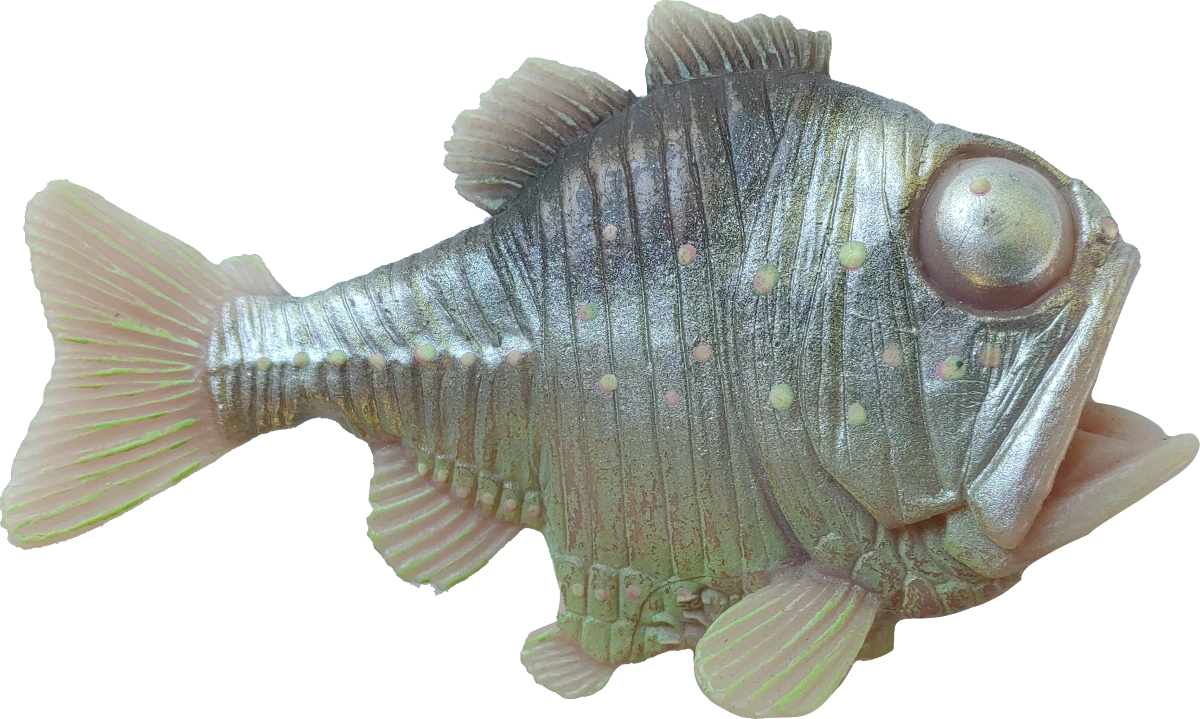
Safari co: Hatchetfish
I didn't care for this one fully as much as the others when I was a kid, but now it's actually one of my top couple favorites. It's highly accurate, including its silvery coloration, while the glow plastic is a dull gummy translucent pink, and it's just a gorgeous effect! They even painted the big, bulging eyes to be silver, like the real thing, but left some exposed pink all the way around the rim.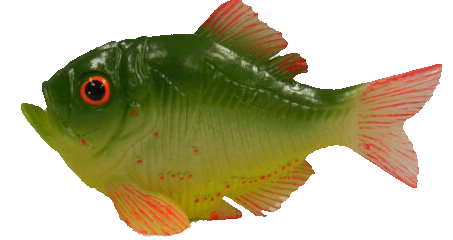
AAA: Hatchetfish
AAA's Hatchetfish is actually a different sculpt, but it's another I've never bought, because it's a much more ordinary looking fish. You would never even guess this was supposed to be a deep sea fish! Its facial proportions and body shape are a bit toned down from most real species in the group, and they gave it a dark green to yellowish color scheme more like an everyday freshwater river fish.
AAA: Batfish
The most unusual sculpt from either set! Walking batfish are actually flattened anglerfish that walk around on their adorable leg-like fins, and usually have a tiny lure situated in a small nose-like orifice on the front, barely visible. Rather than emitting light, these lures are believed to attract prey biochemically, so they don't need to be flashy, literally or figuratively! There are several different deep sea batfish resembling this figure, which is one of the most accurate figures we've now seen, thanks to its pale creamy brown coloration, though they painted its "warts" green so they'd stick out more.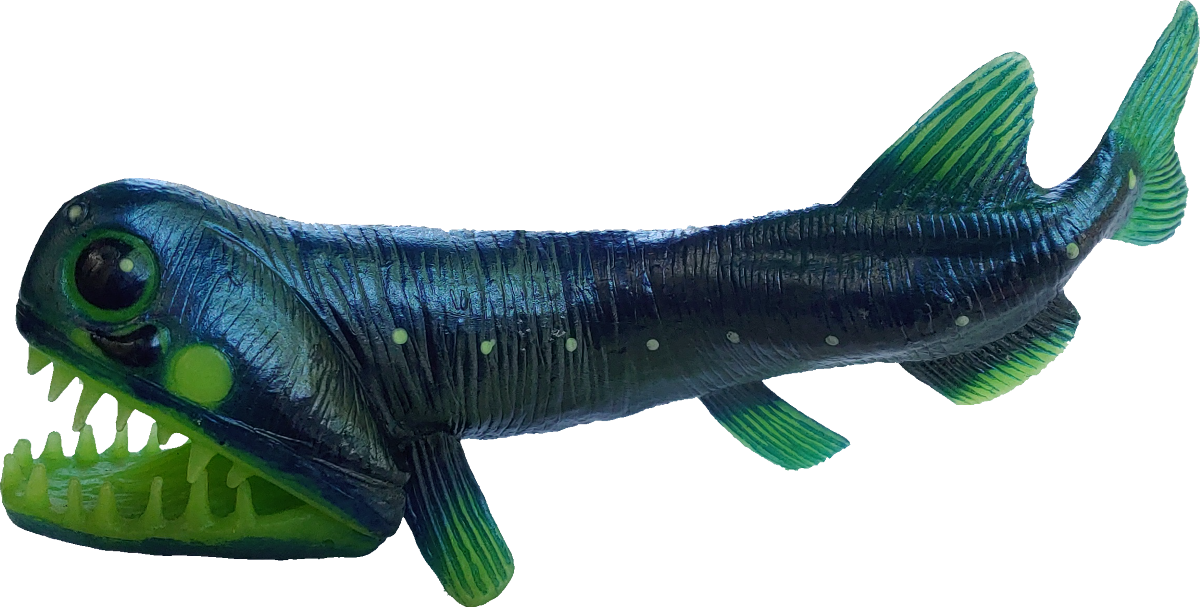
Safari co: Stoplight Loosejaw
One of my favorite deep sea creatures and favorite animals in general! Also called "rat-trap" fish, the loosejaws are basically more specialized dragonfish, and you can see that this figure did represent the "headlights." The slightly curved nodule directly under the eyeball is what emits the infrared, while the large circular spot behind that produces light in a more conventional range. Safari cast this figure in translucent green glow-stuff, which may not be accurate but looks awesome against its much darker metallic blue!Loosejaws are so named because their jaws have no floors at all; the lower jaw is just a fleshless, bony loop with teeth, like a bear trap, and it can practically "detach" from the rest of the body to swing outward, grab prey, and shove it down the throat. It's a shame they didn't represent that in the figure, but it might have caused some difficulty with the molds if they had.
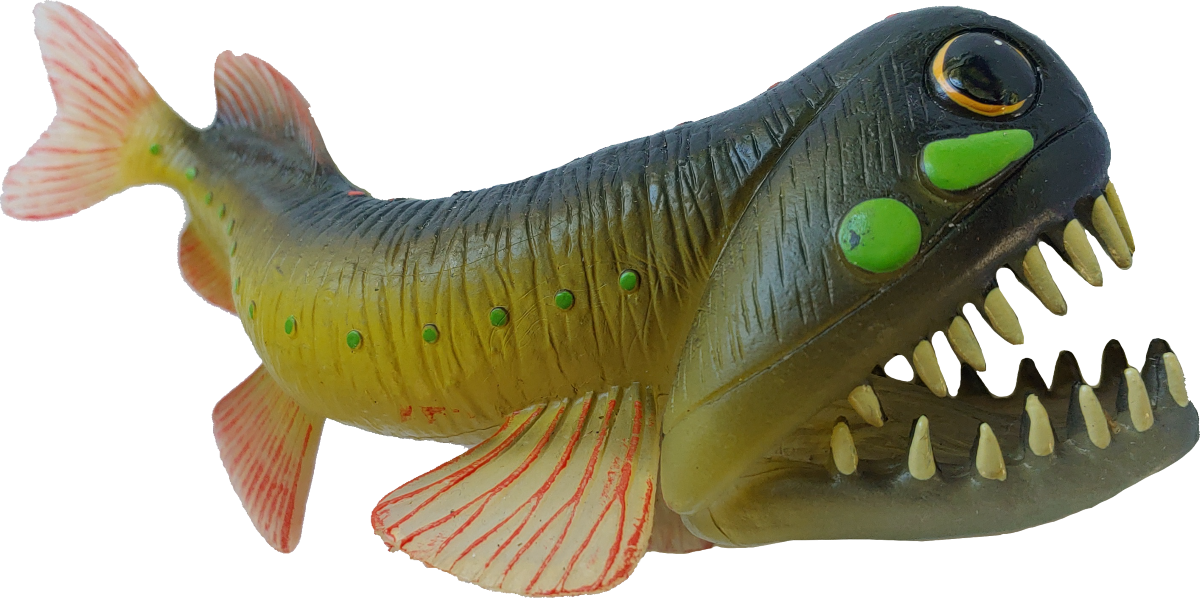
AAA: Stoplight Loosejaw
I love this animal enough that I still bought AAA's imitation, especially because I really like its alternate color scheme; you can tell it's not the same mold as Safari's, with chunkier features and more flared-open fins, but they sculpted it in almost the exact same pose and proportions. Its body color is still less accurate than Safari's, but I really love that swampy greenish, brownish, yellowish palette, and they actually painted the individual teeth so they'd stand out more!
AAA: Barreleye
You may know the barreleyes from the famous Macropinna microstoma, which was filmed alive for the first time in 2004. The famous video revealed that the fish had a thick, transparent dome over its eyes, giving it the appearance of having eyeballs inside of a transparent skull. We know that not all barreleyes have this feature, since there are others we've observed in their natural environment, but this figure appears to be Opisthoprocus soleautus, and we can tell from the anatomy of dead specimens that these DO have the awesome bubble helmet, so it's a crying shame nobody new this when they made this model.For what it is, it's still nicely detailed, even if it's also another one with made-up colors. They decided the tail fins should have a white stripe, and all the fins as well as the "face plate" (where the clear dome would actually attach) are yellow, which kind of gives it a duck-like face. This species has weird, tubular eyes we now know can probably rotate, but in dead specimens they're always sticking straight up, and AAA decided to paint the ends of them intensely blue with comical black pupils. It's not accurate, but it has personality!
It's important you know that this species also has a light in its anus, but we don't exactly know what for.

Safari co: Pelican Eel
It's difficult to photograph this one; with such a funky shape, there's no good angle to really capture all of its charm at once. This is one of the classic, most famous deep sea fish and another of my favorite animals in general, and while they're usually either entirely black or entirely deep red, safari's combination of dark, fleshy red and brown-black makes it the most naturalistic of the line. Its exposed glow plastic is mostly in the dots down its sides and the tip of its tail, which is correct, and in fact they've been observed dangling their luminous tail-tips within their gaping mouths to attract food!My favorite thing about pelican eels however is that their hilarious little eyes are all the way on the very tip of their ridiculous upper jaws. Something about that is exceptionally adorable to me.
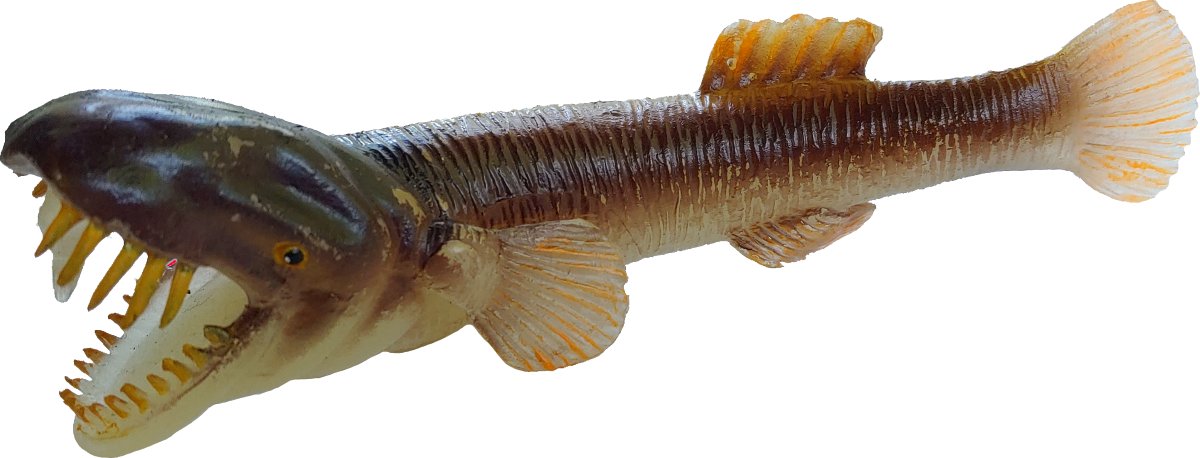
AAA: Wolftrap Anglerfish
THE ONE. When I first saw photographs of the Bottom Feeders, I was blown away that this animal was ever represented in a plastic toy, and it topped my "most wanted" collectibles for years until they finally re-emerged on ebay. I know I said I wasn't willing to spend more money on some of the other figures, but by now, I actually own three of this one; two to decorate with and a third to keep in its package.The wolftrap is another of my favorite creatures on the planet Earth, one of my go-to examples for an extremely bizarre fish. It's an angler with a big, broad, goofy, almost whale-like upper jaw, and maybe that doesn't seem too weird to you at first, but its lure actually hangs from the roof of that jaw, and that's pretty messed up considering the lure of an anglerfish is actually the first ray of its dorsal fin. Evolution twisted the "back fin" of this fish forward until it poked down into the inside of its mouth! What the hell, man! And that's STILL not their wackiest feature!
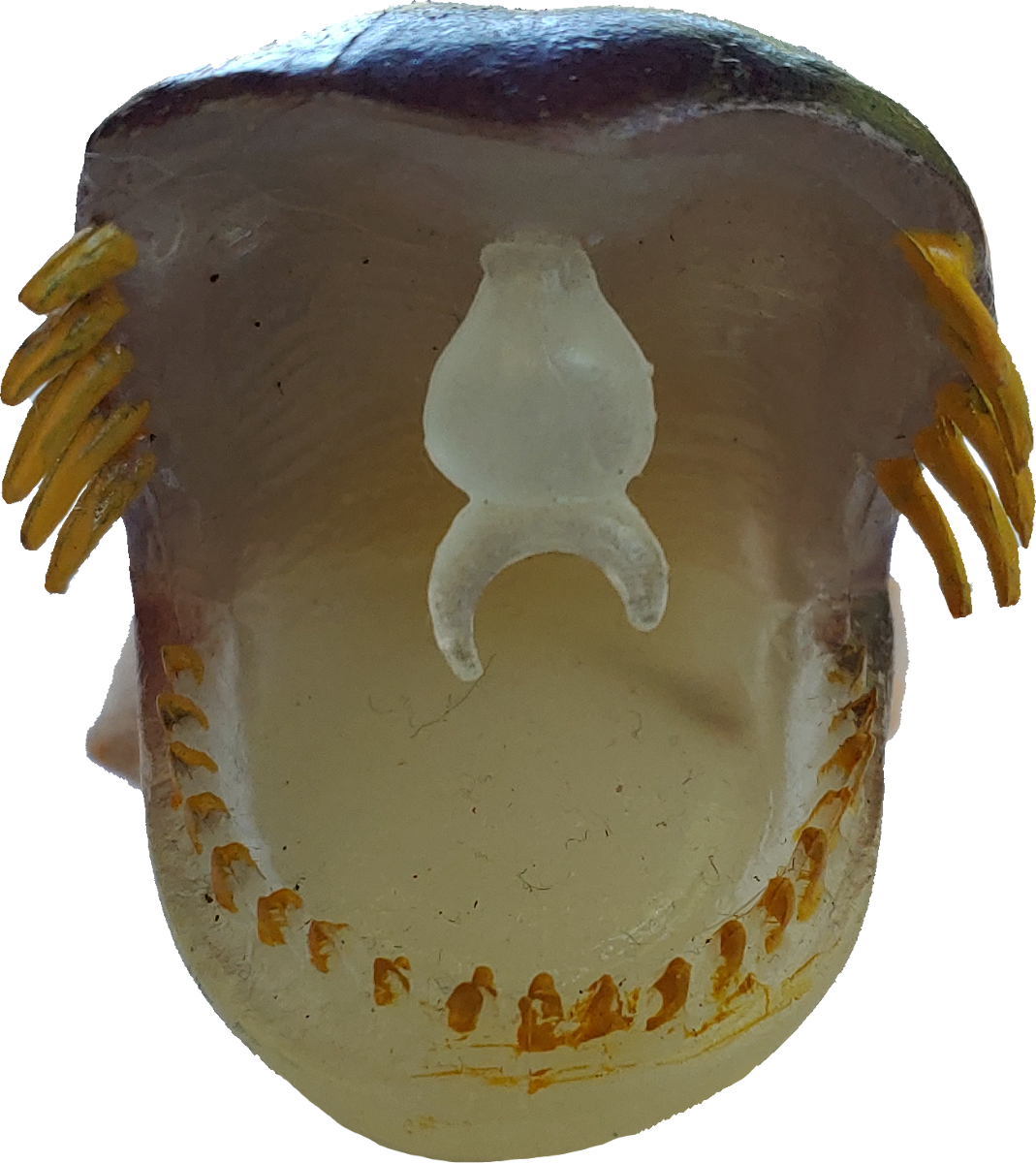
The upper teeth of a "wolf trap," actually also called a "wunderfish," are much longer than the lower, and there are none directly in front, only long rows down the sides. These teeth can swing on hinges to where they're sticking straight up outside of the mouth or almost "clasped," and the upper jaw itself can fold lengthwise like a hot dog bun. This fish basically forms a "tunnel" or "cave" with its mouth, a tasty-looking light-up treat floating inside the enticing entrance, then curls the roof of the cave shut over prey like there's a fly-trap glued to its skull.
It's a fish very few people have heard about, and this single rubbery toy from the 90's was probably its first "pop culture" appearance of any sort. Its second, I'm pretty sure, was its brief appearance in the beloved "Rock Bottom" episode of Spongebob.
